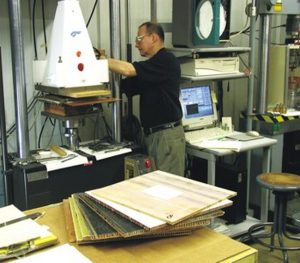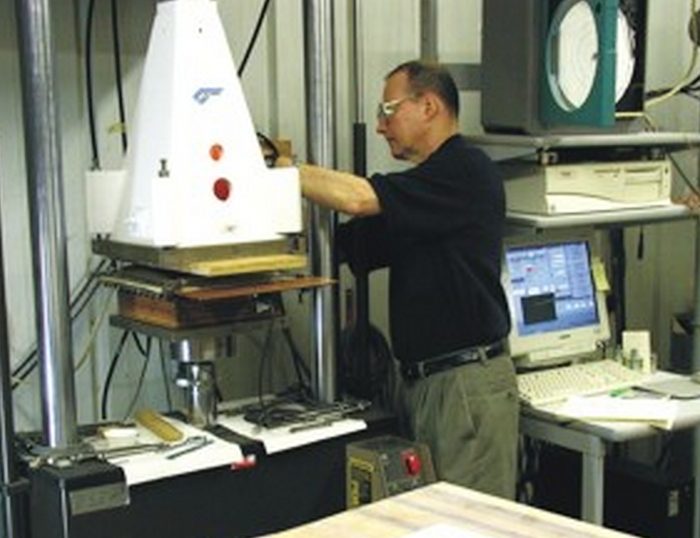
by Bill Bertelsen, GBI Test Engineer

Previous Epoxyworks have reported test results from the “Hydromat,” a unique structural test developed at Gougeon Brothers, Inc. The American Society for Testing and Materials (ASTM), after a rigorous review by its D30 Committee on Composites, approved the Hydromat test method as an official ASTM standard.
The test was invented by Gougeon Brothers’ Chief Test Engineer Bill Bertelsen and was awarded a United States patent in 1995. While the idea of flex-testing boat hull materials is not new, Bill figured out a practical way to apply actual water pressure to the middle of sandwich composite plates, causing them to bulge. This represents a more realistic loading condition than traditional bending test methods.
While the test is designed for evaluating different types of sandwich composite, it can also be used to test plywood or other flat plates of almost any material. Sandwich composite is characterized by having thin layers of high-modulus reinforcing fibers bonded with resin to both faces of a relatively thick, lightweight, low-density “core” material. Typical cores consist of plastic foam, balsa, or honeycomb.
The heart of the test is a self-contained pressure bladder called a Hydromat, which is made of two square pieces of tough industrial belting sealed at the edges.
The prototype holds about 5 gallons of water and works with 24″ x 24″ square panel specimens. A special fixture supports the panel by its edges in a standard servo-hydraulic test machine. With the power on, the actuator begins to squeeze the Hydromat against the surface of the test panel. One sensor records the deflection of the center of the panel while another sensor monitors the contact pressure.
The belting fabric follows the contour of the bulging test panel so that it experiences a nearly uniform, distributed load, even at significant deflections. The Hydromat prototype has withstood pressures as high as 65 psi in static tests. That kind of capacity allows us to learn which constituent part of a particular sandwich composite is most likely to fail when overloaded. This information is of great value to designers who need to ensure adequate strength without adding excess weight. The Hydromat may also be used in fatigue (repeated loading) tests to assess the long term durability of panels. It may be useful in gauging the effectiveness of damage repair techniques as well.
Although Gougeon Brothers currently has equipment to test sandwich structures between 0.25″ and 2.5″ thick, the new ASTM test method is worded to allow the Hydromat system to be scaled to handle almost any thickness. Bill hopes that many composites labs around the country will eventually adopt the test, facilitating the engineering of higher efficiency structures for boats, bridges, and airplanes.





